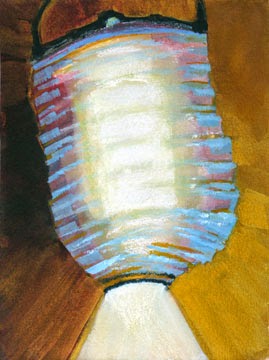Culvert Pool, Independence Pasture
I think this is the first green painting I’ve done out here — summer green. Nets of green algae floating in a golden dust, green reeds growing upright out of the pond muck, cottonwood sucker shoots growing down the bank with cottonwood flowers, making the “cotton” that blows from cottonwoods in the summer.
Roadside Reed Sunset with Fence
Irrigation canals and ditches lace the valley floor, crossing pastures and front yards, often flowing beside roadways and under highways through culverts. In late summer their reeds turn reddish, drying to yellow and white during winter. The low sun shines almost horizontally, flaring in dry reeds and grasses like lanterns.
Winter Field Willow Wheels
Drought has dry-rotted the water trees and scorched the fields tan and dun and grey. Clumps of willows curl as they mummify, resembling old farm machinery left to rust.
Redbirch with Jizo Shrine and Pilgrim
Creek banks are worn with fisherman’s paths and small hollows, like deer beds, where they have crouched, watching staked poles for a yank on the line. I discovered an old tree stump, once whittled into the shape of a chair, now obscured by coyote willow and saplings. Somehow the chair became an image of the Japanese saint Jizo, and the roving fisherman a pilgrim.
Bishop Canal With Wrongway Trailer
Working with greens, pinks, and eggshell colors, I scratched up a canal scene with a palette reminds me of old French tapestry.
Here is a puzzle — why is the trailer “wrongway”?
Sea of Grass with Old Wooden Rowboat, Pt. Pinole
I continue to paint views from Pt. Pinole Regional Park in the Eastbay, based on photos taken there when I lived in Crockett, around 1990, shortly after it was opened to the public. The land juts into the Bay, north of Richmond and south of San Pablo Bay. During the War it was a (remote) site of black powder explosives manufacture and packing. Covered with oatgrass and eucalyptus and odd abandoned structures, foundations, bunkers. It has been developed since, lots of picnic tables, barbecues, kiddie gyms, paved paths with cyclists — but in those early years it was a sort of feral California classic coastal hills place and I often went there with friends to wander around in the seaside summer dusk until the park closed at dark.
Grey Creekside Trio, County Road
Not sure what these trees are — possibly alders? Smooth bark, stunted, broken off, but supporting vertical branches that do look like alder trunks. Dried thickets and stumps line the irrigation watercourses, tangled up in fences and ditch gates and each other, all grey, brittle and leafless in winter.
Borrego Dawn with Derelict Irrigation Tower
Acres of land surrounding the town of Borrego Springs are derelicted agricultural plots, now sand with creosote bush, palm thrash, tumbleweeds. The towers and pipes of irrigation systems stand barren, or like this one, overgrown with some sort of willow vine dried to salmony-brickish color in the heat.
Appaloosa in Winter Pasture
Pack stations corral their horses and mules in the foothills during summer, but when snow shuts down the trails, the animals are moved to pastures in the valley for the winter. Therefore the grey cottonwood trunks, white dry grasses and flaring reddish coyote willow surrounding this horse with appaloosa markings.
Appaloosa in Stableyard
An odd picture — an experiment with the spotted horse meant to remain a sketch — yet I added imaginary stableyard walls and shadows, in color combos I haven’t used before in Eastern Sierra paintings. Don’t know if this is merely a ’sport’ or a possible first peek at a new-to-me color palette.















































